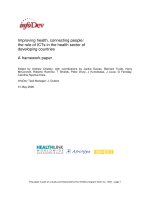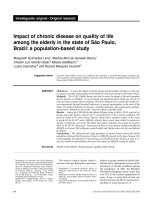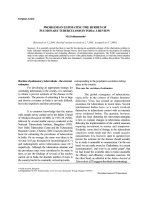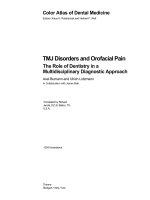THE SITUATION OF CHILDREN IN INDIA A PROFILE doc
Bạn đang xem bản rút gọn của tài liệu. Xem và tải ngay bản đầy đủ của tài liệu tại đây (3.11 MB, 112 trang )
The Situation of Children in India - A Profile
Front Cover PHOTO:
© UNICEF/INDIA/Niklas Halle'n
United Nations Children’s Fund (UNICEF)
May 2011
Permission is required to reproduce any part of this publication.
United Nations Children’s Fund (UNICEF)
73 Lodi Estate
New Delhi - 110003
Email:
Website: www.unicef.in
The Situation of Children in India
A Profile
The Situation of Children in India - A Profile
Contents
Foreword 1
Introduction 3
Child Mortality and Health 4
Child Malnutrition 6
Maternal Health 7
Water, Sanitation and Hygiene 9
HIV/AIDS 12
Disparities and Inequalities (Child Survival and Development) 14
Child Education 20
Disparities and Inequalities in Education 23
Child Protection 28
Children Living in Urban Settings 37
Data Gaps on Children 39
Statistical Profiles of Children in States 41
Sources of Data and Notes for Statistical Profiles of States 43
Andhra Pradesh 45
Assam 48
Bihar 51
Chhattisgarh 54
Delhi 57
Gujarat 60
Haryana 63
Jharkhand 66
Karnataka 69
Kerala 72
Madhya Pradesh 75
Maharashtra 78
Orissa 81
Punjab 84
Rajasthan 87
Tamil Nadu 90
Uttar Pradesh 93
West Bengal 96
Notes and References 99
The Situation of Children in India - A Profile
The story of India is one of growth, gains and
gaps. With an economy that is going from
strength to strength, benefiting from the
demographic dividend of a young and growing
workforce, this largest democracy of the world
is also home to the largest number of children
in the world.
With this growth come real gains for India’s
children and women. Increased government
allocations to social sector programmes in line
with its commitment to inclusive growth, a
progressive policy environment and slew of
social protection schemes, and the strength of
decentralised planning and governance through
the Panchayati Raj system - all contributing to
improving the lives of India’s children and
women.
But with nearly half a billion children in this
country, a lot more remains to be done to
ensure the survival, growth and development
of India’s greatest asset: its children.
Stubbornly high malnutrition rates, poor
sanitation and persistent disparities between
Of Growth, Gains and Gaps
states, social groups and the rich and the poor
are just some of the obstacles we face in
ensuring that every child is reached.
The statistics in this publication tell the story
of people’s lives. Behind each number is the
story of a woman, a mother, an adolescent, a
child. A story of the opportunities and the
obstacles they face in accessing basic services
and realising their rights in a way that is
equitable and non-discriminatory.
UNICEF is committed to ensuring that every
child is reached and putting the last child first.
This is our mission where success will not be
claimed until there is real and lasting change
for children, all children.
Karin Hulshof
Representative, UNICEF India
1
The Situation of Children in India - A Profile
3
India is home to the largest number of children
in the world, significantly larger than the number
in China.
1
The country has 20 per cent of the 0-
4 years’ child population of the world. The
number of live births in the country is estimated
to be 27 million,
2
which again constitutes 20
per cent of the total number of live births in the
world. Although the number of births is expected
to gradually go down in the coming years, the
relative load of India in the world in terms of
child population is not going to lessen
significantly for a long time to come. Therefore,
the progress that India makes towards achieving
the Millennium Development Goals (MDGs) and
targets related to children will continue to
determine the progress that the world will make
towards achieving the MDGs.
The analysis of the situation of children and
women in India would be incomplete without
paying attention to the disparities that exist
between and within states, and the inequalities
that persist among different subgroups of the
population, notably women and girls, Scheduled
Castes, Scheduled Tribes. Disparities can be
identified across several vectors: geography
(between and within states, districts, and sub-
district level), social identity, and gender being
the most notable. National data establishes that
approximately 100 million children are in the
poorest wealth quintile.
3
One half of all the poor
children belong to the Scheduled Castes and
Scheduled Tribes groups and they continue to
be at a significant disadvantage in terms of
MDGs 1, 2, 3, 4, 5 and 7. Vulnerabilities
associated with rapid urbanisation and the
effects of violence also need to be addressed
to reduce inequalities in outcomes for children.
Placing children at the heart of “Inclusive
Growth” strategies will ensure India’s
continuing progress on the economic, social
and political fronts.
Introduction
© UNICEF/INDIA/Graham Crouch
The Situation of Children in India
A Profile
The Situation of Children in India - A Profile
The world food crisis followed by the global
financial meltdown and subsequent economic
recession during 2008-2010 impacted India’s
economy like many other developing countries.
Notwithstanding the upheavals, India’s
economic progress remained resilient enough
to register a growth rate of 6.7 per cent in
2008-2009 and 7.4 per cent in 2009-2010.
4
According to the latest estimates 37 per cent
5
of the population in India lives below the
poverty line, signifying the inequity in
distribution of wealth and household income.
Despite the difficult fiscal situation, the
Government of India has continued to increase
allocation in social sector programmes including
health and education, in line with its
commitment to “Inclusive Growth.”
Child Mortality and Health
India contributes to more than 20 per cent of
the child deaths in the world. Therefore, the
centrality of the discourse on child survival in
the larger discussion on well being of children
in a country like India cannot be emphasized
enough. In India about 1.83 million
6
children
die annually before completing their fifth
birthday – most of them due to preventable
causes. Figure 1 highlights the progress of
different components of child mortality in India
viz. Under-five Mortality Rate (U5MR), Infant
Mortality Rate (IMR) and Neonatal Mortality
Rate (NNMR) since 1990.
7
It is clear that with the current rate of progress
India is likely to miss the MDG 4 (Goal 4) on
child mortality. While the U5MR fell by about
41 per cent between 1990 and 2008, the IMR
declined by 34 per cent during the corresponding
period. This was mainly due to the fact that the
NNMR, which contributes to two thirds of infant
deaths, did not fall appreciably. The early
neonatal mortality (within a week) which
contributes to about 50 per cent of total infant
deaths declined by only 27 per cent during the
corresponding period.
8
While India has made significant gains in child
survival in the age-group 1-4 years since 1990 (56
per cent decline) the overall decline in child mortality
was largely hindered by subdued progress in the
area of neonatal deaths, especially within the first
week of birth. This certainly raises concern on issues
around reproductive health of mothers and early
childhood care in terms of access, use and quality
of the service delivery systems. One of the targets
of the Government of India’s 11
th
Plan is to achieve
by 2012 an anaemia-prevalence rate of 26 per cent
among women between 15-49 years of age. About
56 per cent of currently married women have a
haemoglobin level below 12 g/dl and the prevalence
Figure 1: Child Mortality in India
116
96
69
80
66
53
53
40
35
0
20
40
60
80
100
120
140
1990 2008
Deaths per 1000 live births
U5MR
IMR
NNMR
2001
MDG 4 2015
U5MR: 38
4
of anaemia among girls in the age-group 15-19 years
is also the same. About one third of the currently
married women in the age-group 15-49 years have
Body Mass Index (BMI) less than 18.5 kg/m
2
and
about 47 per cent girls in the age-group 15-19,
have BMI less than 18.5 kg/m
2
.
11
Both factors are
strongly correlated with low birth weight and thus
with unfavourable outcomes for the mother
(increased risk of maternal deaths) and the neonate.
This highlights the need to have focused
interventions for improving maternal nutrition and
adolescent anaemia.
It is clear from above that the coverage levels
of key interventions remain sub-optimal
12
and
require increased efforts to secure improved
survival chances for children in their early
stages of life. This will also contribute to
improving maternal health and reduce maternal
mortality. The level of contraceptive use has
been low and terminal methods of sterilisation,
which are not very effective in spacing between
the deliveries, had the major share among the
different methods used.
Only four diseases – respiratory infections,
diarrhoeal diseases, other infectious and
parasitic diseases and malaria – account for
about half of under-five deaths in India.
13
Respiratory infections and diarrhoeal diseases
together contribute to 36 per cent of all deaths
in children under five years of age. If neonatal
deaths are excluded the proportion of deaths
due to the above causes would be larger, and
most of these are preventable through proper
low cost preventive measures and treatment.
Table 1 gives the coverage and progress (since
1998-1999) on preventive and treatment
measures in India.
14
Although coverage rates for vaccinations have
significantly improved in the recent past, a lot
more needs to be done to protect children with
all vaccinations. According to data available from
5
Reducing neonatal deaths requires improving women’s health during pregnancy, providing
appropriate care for both mother and newborn during and immediately after birth and
caring for the baby during the first weeks of life. Cost-effective, feasible interventions
include initiating breastfeeding within one hour of birth, ensuring proper cord care, keeping
the baby warm and dry, recognizing danger signs and seeking help and giving special care
to infants with low birthweight.
9
Figure 2 shows the key neonatal survival interventions in India.
10
Figure 2: Neonatal survival interventions in India
(in percentage)
35
28
46
41
48
52
50
73
55
Neonatal mortality rate
Low birthweight
Exclusive breastfeeding (< 6 months)
Early initiation of breastfeeding
Postnatal care within two days of birth
Skilled birth attendant
Antenatal care (at least 3 visits)
Tetanus toxoid protection at birth
Contraceptive prevalance rate
Outcomes
The Situation of Children in India - A Profile
the District Level Household Survey (DLHS) for
the year 2007-2008, the coverage rate for
treatment with only oral rehydration solution
(ORS) is 34 per cent. These are not significant
improvements from the earlier rates even if one
were to make adjustments in the figures for
comparability purposes. The recommended
preventive measures for diarrhoea among children
include improved water, sanitation and hygiene,
better nutritional status, exclusive breastfeeding
for children up to six months and continued
breastfeeding until two years and beyond,
immunization and micro-nutrient intakes such as
Vitamin A and Zinc. While the discussion on water,
sanitation, hygiene and child nutrition will follow,
it would be important to mention here that the
current level of Vitamin A intake in the country is
very low. According to the National Family Health
Survey (NFHS) 3 (2005-2006) only 18 per cent
of children aged 6-59 months had received at least
one dose of Vitamin A in the last six months. The
DLHS 3 (2007-2008) reports that only 19 per cent
of children aged 12-35 months had received 3-5
doses of Vitamin A.
Child Malnutrition
Globally, more than one third of under-five
deaths are attributable to under-nutrition.
15
About 20 per cent of children under-age five in
India are wasted, 43 per cent underweight and
48 per cent stunted.
16
In terms of numbers
about 54 million children under five years in
India are underweight which constitutes about
37 percent of the total underweight children in
the world.
17
In India, 25 million children under
five years are wasted and 61 million are stunted,
which constitutes 31 per cent and 28 per cent
of wasted and stunted children respectively in
the world. Figure 3 depicts the trends in stunt-
ing, wasting and underweight status.
18
It is clear that India is not likely to reach the
MDG on child malnutrition, which uses children
underweight as the indicator. Since the MDGs
were adopted in the year 2000, knowledge on
causes and consequences of under-nutrition has
greatly improved.
19
It is now being recognized
that the greatest vulnerability to nutritional
deficiencies is during the period of the mothers’
pregnancy and continues until age two.
Table 1: Coverage on preventive and treatment measures for child health in India - 1998–1999,
2002-04, 2005–2006 and 2007–2008
District Level National Family
Household Surveys Health Surveys
Indicator
2002-04 2007-08 1998-99 2005-06
Children age 12-23 months received DPT 3 58 64 55 55
vaccine (%)
Children age 12-23 months received measles 63 69 51 59
vaccine (%)
Children age 12-23 months received all 46 54 42 44
vaccinations (%)
Children with diarrhoea in last two weeks treated - - 42 46
with oral rehydration solution and gruel (%)
Children with acute respiratory systems taken
to a health facility or provider (%) - - 64 69
© UNICEF/INDIA/Giacomo Pirozzi
6
7
Figure 3: Trends in stunting, wasting and underweight status of children age
three years, India - 1998-1999, 2005-2006
Therefore, there is a critical window of
opportunity to prevent under-nutrition – while
the mother is pregnant and during child’s first
two years of life – when proven nutrition
interventions offer children the best chance to
survive and reach optimal growth and
development; after that window closes, the
damage to children is largely irreparable. There
is a growing emphasis on the problem of stunting
(measured by height for age) and anaemia in
the first two years of life as they not only impact
child survival and growth, but also result in
diminished cognitive development, school
performance and physical development. This
also has an adverse inter-generational impact
in terms of productivity, poverty, and for
women, higher risk of pregnancy-related
complications and low birthweight babies which
in turn, reinforces the vicious cycle of under-
nutrition. Therefore, there is a need to increase
the programme focus on chronic under-nutrition
in particular.
Marked reductions in child under-nutrition can
be achieved through improvements in women’s
nutrition before and during pregnancy, early and
exclusive breastfeeding in the first six months
of life, and good quality complementary feeding
with continued breastfeeding for children 6-23
months old with appropriate micro-nutrient
interventions.
20
It has already been seen above
that the nutritional status of women in the
reproductive period is poor and breastfeeding
practices rates are sub-optimal and
micronutrient intake is far from satisfactory.
Complimentary feeding practices (which is
considered to be most effective intervention
for reducing stunting) are low as only 57 per
cent
21
of infants 6-9 months are fed
complementary foods in a timely manner and
only 22 per cent of breastfed children 6-23
months old are fed with three or more food
groups and minimum number of times.
22
© UNICEF/INDIA/Tom Pietrasik
51
20
43
45
23
40
Stunted Wasted Underweight
1998-99 2005-06
Note: Nutritional status
estimates are based on the
2006 WHO International
Reference Population
The Situation of Children in India - A Profile
Maternal Health
The factors that cause pre-term birth and
neonatal deaths are also largely responsible for
maternal deaths. The poor status of women’s
health, nutrition and care during pregnancy has
been adequately highlighted in the discussion
above. The Maternal Mortality Ratio (MMR) for
India for the period 2004-2006 was 254 per
8
Figure 4: Causes of maternal deaths in India - 2001-2003
38 %
11 %
5 %
5 %
8 %
34 %
Haemorrhage
Sepsis
Hypertensive disorder
Obstructed labour
Abortion
Other conditions
100,000 live births, which declined from 301
estimated during 2001-2003.
23
According to
the latest estimates developed by the UN Inter-
agency group, the MMR for India in 2008 is
230.
24
The availability of data on MMR in India
in the past was sporadic. If one considers the
MMR obtained from the first National Family
Health Survey conducted in 1992-1993 as the
starting point of MDG 5, India has to reach
108 in 2015, a target, which seems to be a
challenge at the current rate of progress.
25
The
MMR estimated for India by UN Inter-agency
group for the year 1990 is 570, re-setting the
MDG target for 2015 as 143 and thus,
acknowledging that India is ‘making progress’
so far as the MDG Goal is concerned.
26
Figure 4 gives the causes of maternal deaths
in India.
27
The figure above shows that haemorrhage and
sepsis which are predisposed to a great extent
© UNICEF/INDIA/Tom Pietrasik
care.
28
It is known that the antenatal care
services and skilled delivery care remain low
and about 59 per cent of women have had no
postnatal check up at all.
29
In 2005, India
introduced the cash assistance scheme for
institutional delivery with the objective of
reducing maternal mortality and neonatal
mortality.
30
This has improved the percentage
of institutional deliveries from 41 per cent in
by maternal anaemia, contribute to almost half
of the maternal deaths. Women with chronic
malnutrition are vulnerable to obstructed
labour. The specific interventions that can
reduce the elevated risk of morbidity and
mortality due to complications before, during
and after birth are antenatal care, skilled
attendance at birth, emergency obstetric care,
post-partum care, contraception and family
planning delivered across a continuum of
2005-2006 to 47 per cent in 2007-2008.
31
However, the quality of maternal care is lacking
as is seen from the Figure 5 on some of relevant
indicators.
32
Reducing the number of unwanted pregnancies
reduces the risk of maternal deaths. The
contraceptive prevalence rate is only about 55
per cent leaving the rest of the women exposed
to the risk of pregnancy, in many cases
unwanted. Unmet need on contraception
(limiting and spacing) is 21 per cent.
33
About
16 per cent of girls in the age-group 15-19
have begun childbearing (either have had a live
birth or pregnant with the first child).
34
The poor
status of health of child-bearing adolescents,
coupled with physiological immaturity elevates
the risk of maternal and perinatal deaths. The
adolescent fertility in India is a consequence
of early marriage. About 43 per cent of
currently married women in the age-group 20-
24 married before age 18 years, a marginal
decline from the level of 50 per cent in 1998-
1999.
35
Water, Sanitation and
Hygiene
The combined effects of inadequate sanitation,
unsafe water supply and poor personal hygiene
are responsible for 88 per cent of childhood
deaths from diarrhoea.
36
Poor sanitation and
unsafe drinking water cause intestinal worm
infections, which lead to malnutrition, anaemia
and retarded growth among children.
India’s progress on improved drinking water
sources
37
since 1990 is shown in Figure 6.
38
India has reached the MDG Goal 7 target on
improved drinking water sources. However, the
piped water as a drinking water source has
remained as low as 24 per cent.
39
Contamination of water on account of arsenic
and fluoride are new challenges that India has
to cope with and find solutions to.
9
Figure 5: Quality of maternal care in India
(in percentage)
27
47
46
45
Postnatal check within 4 hours of delivery
100 IFA tablets consumed
Blood pressure measured
Antenatal check up in the first trimester
© UNICEF/NYHQ/Graham Crouch
The Situation of Children in India - A Profile
Sanitation is one of the biggest challenges in India
As indicated in Figure 7, in 2008, only 31
40
per
cent of the population in the country benefitted
from improved sanitation.
41
According to the Joint Monitoring Programme
(JMP) estimates for India about 638 million
10
Figure 6: Trends in coverage of improved drinking water sources in India - 1990-2008
Figure 7: Trends in improved sanitation coverage in India - 1990-2008
people in India defecate in the open, which is
55 per cent of the total population defecating
Campaign (TSC) programme (introduced in the
year 2000) may have provided the impetus for
18
25
31
0
20
40
60
80
100
1990
2000
2008
MDG 7 2015 59%
in the open in the world.
42
However, it would
be clear from the Figure 8 that the number of
persons defecating in the open has substantially
decreased by 19 million between 2000 and
2008, when the population during the
corresponding period increased by 139 million.
This suggests that the Total Sanitation
19
20
24
72
81
88
86
0
10
20
30
40
50
60
70
80
90
100
Piped drinking water Improved drinking water
MDG 7 2015: 86 %
accelerated increse in the use of toilets.
Therefore, there is also a need to look at the
behavioral aspects of the individuals in the
household in terms of the use of toilet, which
again may vary with age and gender. There
perhaps is a need to undertake more research
to find answers as to ‘why’ individuals do not
use toilets.
Hand-washing with soap before eating and after
defecation, has been one of the major
interventions on hygiene practice, which is
being promoted among children in India through
the school hygiene programme and mass media
campaign. A survey on well being of children
and women, conducted by UNICEF in 2005,
had shown that only 47 per cent of rural
children in the age-group 5-14 wash hands after
defecation.
43
The rural-urban disparity in terms of use of
toilet is very stark as will be seen from the
11
Figure 8: Population using toilet and population defecating in open in India - 1990-2008
(in million)
638
657
638
224
386
543
1990 2000 2008
Population defecating in open Population using toilet
Figure 9: Trends in use of toilets by households in India - 1998-1999, 2007-2008
18.9
19.2
26.0
34.2
80.7
79.9
83.2
80.8
0
10
20
30
40
50
60
70
80
90
1998
-
1999 2002
-
2004 2005
-
2006 2007
-
2008
Rural
Urban
The Situation of Children in India - A Profile
Figure 9.
44
It will be, however, important to
observe that while in urban areas the
households using toilets have been more or less
stagnant in the last 10 years, there has been
significant improvements in rural areas during
the corresponding period. In urban areas about
a quarter of households share toilets with other
households.
45
In Mumbai, more than two-thirds
of households (three-fourths of households
living in slums) share toilets.
The inter-state disparity in usage of toilets is
also very significant. Among the major states,
Kerala fares the best with 97 per cent of the
households using any toilet followed by Assam
(70 per cent) and West Bengal (56 per cent).
The worst performing three states are
Jharkhand (15 per cent), Bihar and Orissa (17
per cent). Ironically, Tamil Nadu which has
made significant progress in all social and
economic indicators has less than 40 per cent
of its households using any kind of toilet.
Recent initiatives of the Government of India,
including the Food Security Bill, the Right to
Health Bill and the Policy on Early Childhood
Care and Development indicate that efforts
for strengthening the rights framework on
several fronts by the government may have
significant implications for strengthening the
child survival and development outcomes for
children.
HIV/AIDS
The National AIDS Control Organization (NACO)
has reported an overall reduction in adult HIV
prevalence and HIV new incidences in India.
India had an estimated 2.44 million living with
HIV/AIDS in 2009,
46
the adult prevalence being
0.32 per cent in 2009.
47
The estimated
prevalence among males is 0.38 per cent which
continues to be higher than females (0.26 per
cent).
48
Out of the total estimated Persons
Living with HIV/AIDS (PLHA), 83 per cent are
in the age group 15-49 years, and 3.5 per cent
are children below age 15 years
49
. This means
that around 0.1 million children below age 15
are living with HIV/AIDS.
50
Of all the HIV
infections, around 39 per cent is among
women. The estimated number of PLHA and
estimated Adult Prevalence Rate is depicted in
the Figure 10.
51
Figure 10 highlights that both the prevalence
rate and the estimated number of PLHA are
on the decline and therefore India can claim
to have halted and reversed the spread of HIV/
AIDS.
52
In 2009, the estimated Adult HIV
prevalence remains high in Manipur (1.40 per
cent) and Nagaland (0.78 per cent).
53
Andhra
Pradesh has an estimated adult HIV prevalence
of 0.90 per cent while Karnataka and
Figure 10: Estimated number of PLHA and Adult prevalence rate in India - 2004-
2008
12
0.31
0.37
0.36
0.34
0.32
2.61
2.58
2.54
2.49
2.44
0.0
0.1
0.2
0.3
0.4
0.0
0.5
1.0
1.5
2.0
2.5
3.0
2004 2005 2006 2007 2008
Estimated Adult prevalance Estimated number of PLHA (in million)
Maharashtra have estimated adult HIV preva-
lence less than one per cent. While all high
prevalence states had shown decline in preva-
lence between 2006 and 2009, rising trends
are noted in some new states namely Orissa,
Assam, Chandigarh, Kerala, Jharkhand and
Meghalaya. It may be noted that though preva-
lence is declining, in terms of absolute num-
bers, it may not be so because of large popu-
lation size.
The epidemic in India is higher in urban areas
than rural areas and greater among males than
females. India continues to be in the category
of concentrated epidemic as the HIV prevalence
among the High Risk Groups (HRG) is very high
compared to that among the general population.
The heterosexual activity continues to be the
major route of transmission (87.1 per cent).
54
Among pregnant women of 15 - 24 years, the
prevalence has declined from 0.86 per cent in
2004 to 0.49 per cent in 2007. A drop by more
than 50 per cent has been recorded among
pregnant women aged 25 49 years as well:
from 1.09 per cent in 2004 to 0.52per cent in
2007.
55
The Joint Technical Mission on PPTCT
in 2006 estimated that out of 27 million
pregnancies, about 0.19 million occur in HIV
positive mothers.
In the past few years, India has made rapid
improvement in provision of services on
prevention and treatment of HIV/AIDS. The
number of Integrated Counseling and Testing
Centres (ICTC) increased from only 2815 in
2005-2006 to 5135 till December 2009 and
the number of persons tested in the
corresponding year increased from 2.7 million
to more than 7 million. The number of
pregnant women counseled under the PPTCT
services increased from 1.3 million in 2005
to 4.4 million in 2009. In 2009, about 15
thousand pregnant women tested for HIV
positive and were treated at the time of
delivery along with the newborn.
56
The
number of patients on Anti-Retroviral Therapy
(ART) increased from 69 thousand in March
2007 to 281 thousand by January 2010 and
that for children increased from 6 thousand
to 19 thousand during the corresponding
period. The DLHS 3 Survey (2007-2008)
reveals that out of all the women who have
heard about HIV/AIDS,
57
61 per cent knew
the place to go for HIV/AIDS testing and
around 11 per cent underwent actual test.
The MDG Goal 6 specifies two indicators on
prevention, one on comprehensive knowledge
and the other on safe behavior.
58
The progress
13
Figure 11: Percentage of population in the age-group 15-24 with comprehensive
correct knowledge on HIV/AIDS on transmission and prevention in India - 2001
and 2006
17.7
13.8
35.8
29.3
Male Female
2001
2006
Base: All respondents aware of HIV/AIDS
The Situation of Children in India - A Profile
in respect of the comprehensive knowledge is
depicted in the Figure 11.
59
Out of all youth who had reported sex with
non-regular partner in the last six months, the
percentage who reported to have used condom
during the last sex increased from 52 per cent
in 2001 to 62 per cent in 2006 (males from 53
to 62 per cent and females from 48 to 61 per
cent).
60
At the national level nearly two-fifths of the youth felt that PLHA should not be allowed
to stay in their village/community. Further, a similar proportion of the respondents expressed
their unwillingness to share food with PLHA. As stigma and discrimination against PLHA
impede the effectiveness of HIV/AIDS prevention and care efforts, the AIDS awareness
programmes should continue to pay focused attention to dispel the stigma and unnecessary
fears from the minds of young people.
61
The Ministry of Health and Family Welfare
(MOHFW) and MWCD released a Policy
Framework for Children and AIDS in India in
2007. The nature of HIV/AIDs is that it leads
to violations of basic rights of children and
needs to be addressed as a concerted effort
by all concerned Ministries responsible for the
well-being of children. Coordination and
collaboration mechanisms between Ministries
to operationalise the Policy are yet to be put in
place.
The South Asian Association for Regional
Cooperation Framework for Protection, Care
and Support of Children Affected by HIV/AIDS
was also approved in 2006 and guidelines and
core indicators have been identified for
measuring progress.
through several consultations and inputs by key
stakeholders and it is expected that a revised
version may be introduced in Parliament soon.
Disparities and Inequalities
(Child Survival and Development)
The analysis of the situation on children and
women in India in terms of the levels and
progress of related indicators remains
incomplete and irrelevant if it does not highlight
the disparities that exist among states and the
inequalities that persist among different sub-
groups of the population.
62
This is not only
important, but also essential for better targeting
in terms of improved and pragmatic programme
focus. The discussion in the note with regard
to disparity and inequality will be limited to only
three key indicators, namely Child Mortality,
Maternal Mortality and Child Education as many
of the other indicators link to these in the cause
and effect chain.
63
Child Mortality
Table 2 highlights the three worst and three
best performing states
64
in terms of Under-five
mortality rates (U5MR). The Infant mortality
rates (IMR) and Neonatal mortality rates
(NNMR) for these states are also provided.
65
© UNICEF/INDIA/Candace Feit
The single most adverse impact of HIV/AIDS
is stigma and discrimination, which may result
in denial of basic services to affected children,
especially health and education services or
result in segregation, neglect and humiliation
by service providers and often the community
themselves.
The HIV/AIDS draft Bill which addresses these
issues has been on hold since 2006. It has gone
14
The disparities in estimates of child mortality
between the worst and best categories of
states are evocatively high. The states with
high child mortality also have relatively higher
burdens in terms of the number of child deaths
Table 2: Best performing and worst performing states in child mortality - 2008
States U5MR IMR NNMR
Worst performing
Madhya Pradesh 92 70 48
Uttar Pradesh 91 67 45
Orissa 89 69 47
Best performing
Kerala 14 12 7
Tamil Nadu 36 31 21
Maharashtra 41 33 24
Figure 12: Burden of child mortality of eight worst performing states as a percentage
to India - 2008
47.2%
57.1%
69.9%
68.2%
Population Live births Under
-five deaths Infant deaths
in the country. This is explained clearly by
Figure 12 which uses the worst eight states
(with highest U5MR) to illustrate the point.
66
The eight states are Madhya Pradesh, Uttar
Pradesh, Orissa, Assam, Rajasthan, Bihar,
Chhattisgarh and Jharkhand.
The figure above indicates that while these
eight states together contribute to 47 per cent
of the population and 57 per cent of the live
births in the country, they have a burden of
almost 70 per cent of under-five and infant
deaths. It would be interesting to note that
© UNICEF/INDIA/Alistair Gretarsson
15
these eight states contribute to about 15 per
cent of child deaths in the world.
67
Table 3 provides the progress made by a few
selected states in terms of IMR, the MDG 4
The Situation of Children in India - A Profile
and Government of India IMR targets for the
year 2015 and 2012.
68
Among the worst performing states only Orissa
had shown remarkable decline in IMR since
1990, mirroring the progress made by the two
best performing states namely, Maharashtra
and Tamil Nadu. Assam has been the most
disappointing story; Uttar Pradesh and
Rajasthan too have progressed slowly. At the
current rate of progress among the above six,
Tamil Nadu and Maharashtra are the only states
likely to achieve the MDG targets, although the
Government of India targets appear to be a tall
order.
Figure 13
69
highlights the inequalities and dis-
parities in the levels of child mortality (U5MR).
Table 3: Progress of a few major states in achievement of MDG and Government of India targets
on Infant Mortality Rates for selected states
IMR 1990 IMR 2008 Percentage MDG 4 Government of India
decline Target Target 2012
1990-2008 2015
Orissa 122 69 43.4 41 37
Uttar Pradesh 99 67 32.3 33 35
Rajasthan 84 63 25.0 28 32
Assam 76 65 14.5 25 32
Tamil Nadu 59 31 47.5 20 20
Maharashtra 58 33 43.1 19 17
Figure 13: Disparity in levels of under-five mortality by various characteristics
33.8
100.5
59.2
95.7
88.1
52.8
70.0
76.0
51.7
82.0
79.2
69.7
Highest quintile
Lowest quintile
Others
Scheduled Tribes
Scheduled Castes
Christian
Muslim
Hindu
Urban
Rural
Female
Male
India Average 74
16
It can be seen that a child who is born in the
Scheduled Tribes household is one and half
times as likely to die before reaching his/her
fifth birthday as compared to a child born in
the ‘Others’ household. A child born in the
poorest household is three times as likely to
die before its fifth birthday as compared to a
child born in the richest household.
The trends in U5MR for different sub-
populations since 1992-1993 are shown in
Figure 14.
70
Figure 14: Trends in U5MR in India by different population characteristics:
Residence, Sex and Scheduled Castes and Scheduled Tribes - 1992-1993 to 2005-
2006
130.9
111.5
82.0
78.3
65.4
51.7
0
20
40
60
80
100
120
140
1992-1993 1998-1999 2005-2006
Rural Urban
122.4
105.2
79.2
115.4
97.2
69.7
0
20
40
60
80
100
120
140
1992-1993 1998-1999 2005-2006
Male Female
149.1
119.3
88.1
135.2
126.6
95.7
111.5
82.6
59.2
0
20
40
60
80
100
120
140
160
1992-1993 1998-1999 2005-2006
Scheduled Castes Scheduled Tribes Others
As stated earlier, under-nutrition contributes
to more than one-third of under-five deaths.
Trends in children underweight by wealth
quintile between 1992-1993 and 2005-2006
as is depicted in Figure 15 clearly highlights
the fact that there has not been significant
decline in underweight prevalence among
under-five children in the lowest quintile.
17
Although there has been significant progress
in all categories of populations, the gaps have
remained more or less same and in some cases
widened (for example between Scheduled
Tribes and Others).
The Situation of Children in India - A Profile
Figure 15: Trend in percentage of children age 0-59 months who were underweight
by wealth quintiles India - 1993, 2006
64
63
60
51
37
61
55
47
40
25
Poorest 20% Second 20% Middle 20% Fourth 20% Richest 20%
1993
2006
Maternal Mortality
The level and progress of Maternal Mortality Ratio (MMR) across states is shown in Figure 16
Figure 16: Maternal mortality ratio by states
18
0
100
200
300
400
500
600
Deaths per 1,00,000 live births
2001 -2003
2004 -2006
The Supreme Court has given special directives
on Universalization of all Integrated Child
Development Services (ICDS) services to all
children below six years, pregnant and lactating
mothers, adolescent girls in all rural habitations
and urban slums in a progressive manner.
Universalization of ICDS with quality,
accelerated implementation of these directives
and monitoring delivery of these entitlements
are essential for accelerating progress in
reducing malnutrition.
The state with highest MMR of 480 per
100,000 live births is Assam followed by Uttar
Pradesh (440) and the best performing state
inevitably happens to be Kerala with a MMR of
98 with the next best being Tamil Nadu (111).
While 58 per cent of live births occur in the
worst eight states (of MMR), together they
contribute to 86 per cent of the total maternal
deaths in India.
Figure 17: Disparity in coverage (in per cent) of safe deliveries by various population
characteristics in India - 2007-2008
84.9
23.6
64.3
37.6
47.7
48.5
52.7
75.6
43.3
Highest Quintile
Lowest Quintile
Others
Scheduled Tribes
Scheduled Castes
Muslim
Hindu
Urban
Rural
India 52.3 %
in the poorest household is more than four times
less likely to receive skilled delivery care than
a woman living in the richest household.
© UNICEF/INDIA/Graham Crouch
19
Since disaggregated data for MMR by social/
religious groups, rural-urban and household
poverty levels are not available, the percentage
of safe deliveries have been used to examine
the extent of inequality.
71
Wide disparities exist between different
sections of the population in terms of their
obtaining skilled delivery care. A woman living
in an urban area is about twice as likely to get
skilled delivery care as compared to a woman
living in a rural area. Similarly, a woman living









